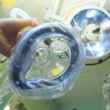This work supports previous observations on the mortality benefit of regional (and even local) anesthesia in patients who undergo elective endovascular aneurysm repair for the treatment of infrarenal abdominal aortic aneurysms. These benefits also translated into a shorter hospital stay, but not into less pulmonary complications, which is what previous studies had suggested. Minimally invasive...
Frailty and Bleeding: Impact on Aortic Valve Replacement
Courtesy of Dr. Carlos Fava. We are well aware that both transcatheter aortic valve replacement (TAVR) and surgical valve replacement (SAVR) generate bleeding (15% to 22% for TAVR and 22% to 44% for SAVR). Frail patients constitute a particular group. These have not yet been assessed as to the real risk they run and mortality...
Leaflet Thickening and Immobility in Evolut Low Risk
Leaflet thickening and immobility caused by thrombosis have been reported for both surgical and transcatheter bioprostheses. This phenomenon is diagnosed through hypoattenuation, thickening, and lack of motion, as observed through computed tomography (CT) imaging. The incidence and, especially, the clinical implications of this phenomenon remain unclear, but they are of great interest, particularly in a...
Blood Pressure Variability and Subclinical Brain Disease
Elevated blood pressure variability was associated with a wide range of subclinical structural changes in the brain. These structural changes could be the mechanisms explaining a higher incidence of dementia and stroke. This study included 2348 participants age ≥55 years in a prospective cohort. Blood pressure was measured in each visit since 1990, and since 2005 all...
The Most Read Scientific Articles of May in Interventional Cardiology
01- Management of Infarction During the COVID-19 Pandemic Patients with cardiovascular disease infected with COVID-19 are at a particular risk for morbidity and mortality. In any case, it should be noted that most patients requiring cardiovascular care due to ischemic heart disease, peripheral vascular disease, or structural heart disease are not infected. Read more HERE...
Antiaggregation vs. Anticoagulation after Peripheral PCI
The truth is this question has no clear answer and what with do with peripheral stenting is transfer the evidence we have on coronary stenting, given the lack of standards and poor reporting on antithrombotic therapy outcomes in randomized studies on endovascular intervention. Heterogeneity is worse when it comes to venous territory. Some time ago...
Aligning Prosthetic Valves to Native Commissures: The Secret to Coronary Artery Obstruction?
Preventing coronary artery obstruction during transcatheter aortic valve replacement (TAVR) continues to be a challenge. There are techniques to prevent (or at least reduce) this from happening, which could be catastrophic. However, they all somehow fall into palliative care, that is, they will merely provide relief, rather than a cure. Commissure overlapping and the resulting...
In Search of the Optimal Depth for Self-Expandable Valves
Despite the use of the different imaging approaches to calculating implantation depth, optimal depth is reached only 30% of the time. Multiple imaging does not offer a uniform perspective and therefore influence reporting. Basically, we do not have a clear idea of what constitutes optimal depth on a case by case basis and, what is...
The most read scientific articles on interventional cardiology in april
01- ECS Guidelines for COVID-19 Management One of the first statements in this document points out these are not “regular guidelines” developed after thorough analysis of all the available evidence published since the last update. Instead, they are meant to provide temporary basic management pointers on how to handle different scenarios of cardiac patients in the...
SURTAVI Follow-Up Completed with Good News
The assessment of all severe aortic stenosis patients at intermediate risk of the SURTAVI was finally completed, confirming inferiority against the traditional surgical replacement (SAVR) in hard points such as all-cause mortality and disabling stroke. The aim of this study was to report SURTAVI 2-year outcomes (Surgical Replacement and Transcatheter Aortic Valve Implantation) and confirm...









